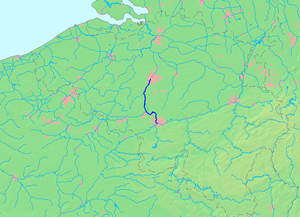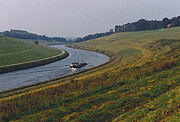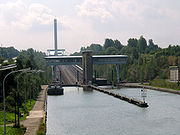
Brussels-Charleroi Canal
Encyclopedia

Canal
Canals are man-made channels for water. There are two types of canal:#Waterways: navigable transportation canals used for carrying ships and boats shipping goods and conveying people, further subdivided into two kinds:...
in Belgium
Belgium
Belgium , officially the Kingdom of Belgium, is a federal state in Western Europe. It is a founding member of the European Union and hosts the EU's headquarters, and those of several other major international organisations such as NATO.Belgium is also a member of, or affiliated to, many...
. The canal is quite large, with a Class IV Freycinet gauge
Freycinet gauge
The Freycinet gauge is a standard governing the dimensions of the locks of some canals, put in place as a result of a law passed during the tenure of Charles de Freycinet as prime minister of France, dating from 5 August 1879....
, and its Wallonian portion is 47.9 kilometres (29.8 mi) long. It runs from Charleroi
Charleroi
Charleroi is a city and a municipality of Wallonia, located in the province of Hainaut, Belgium. , the total population of Charleroi was 201,593. The metropolitan area, including the outer commuter zone, covers an area of and had a total population of 522,522 as of 1 January 2008, ranking it as...
in the south to Brussels
Brussels
Brussels , officially the Brussels Region or Brussels-Capital Region , is the capital of Belgium and the de facto capital of the European Union...
in the north. It is part of a north-south axis of water transport in Belgium, whereby the north of France
France
The French Republic , The French Republic , The French Republic , (commonly known as France , is a unitary semi-presidential republic in Western Europe with several overseas territories and islands located on other continents and in the Indian, Pacific, and Atlantic oceans. Metropolitan France...
(via the Canal du Centre
Canal du Centre (Belgium)
The Canal du Centre is a canal in Belgium, which, with other canals, links the waterways of the Meuse and Scheldt rivers. It has a total length of 20.9 km. It connects the artificial lake Grand Large near Nimy, with the Brussels-Charleroi Canal near Seneffe....
) including Lille
Lille
Lille is a city in northern France . It is the principal city of the Lille Métropole, the fourth-largest metropolitan area in the country behind those of Paris, Lyon and Marseille. Lille is situated on the Deûle River, near France's border with Belgium...
and Dunkirk and important waterways in the south of Belgium including the Sambre
Sambre
The Sambre is a river in northern France and Wallonia, southern Belgium, left tributary of the Meuse River. The ancient Romans called the river Sabis.-Course:...
valley and sillon industriel
Sillon industriel
The sillon industriel is the former industrial backbone of Wallonia and thus of Belgium. It runs across Wallonia, passing from Dour, in Borinage, in the west, to Verviers in the east, through Mons, La Louvière, Charleroi, Namur, Huy, and Liège, following the valleys of the rivers Haine, Sambre,...
are linked to the port of Antwerp in the north, via the Brussels-Scheldt Maritime Canal
Brussels-Scheldt Maritime Canal
The Brussels–Scheldt Maritime Canal, also named the Willebroek Canal, is a canal in Belgium linking Brussels with the river Scheldt. The canal was known as the Brussels-Rupel Maritime Canal, prior to the establishment of a direct link with the Scheldt in 1997.The canal is one of the oldest...
.
The Ronquières inclined plane
Ronquières inclined plane
The Ronquières Inclined Plane is a Belgian canal inclined plane on the Brussels-Charleroi Canal in the province of Hainaut in Wallonia that opened in April 1968 after a six year construction period...
is the most remarkable feature of the canal.
Early proposals

Duke of Burgundy
Duke of Burgundy was a title borne by the rulers of the Duchy of Burgundy, a small portion of traditional lands of Burgundians west of river Saône which in 843 was allotted to Charles the Bald's kingdom of West Franks...
(1396–1467). In 1436, an edict authorized the modification and deepening of the Senne
Senné
Senné is a village and municipality in the Veľký Krtíš District of the Banská Bystrica Region of southern Slovakia.-External links:*http://www.statistics.sk/mosmis/eng/run.html...
River, though the project turned out to be more expensive than previously thought. The city of Mechelen
Mechelen
Mechelen Footnote: Mechelen became known in English as 'Mechlin' from which the adjective 'Mechlinian' is derived...
, the sole city allowed to tax water transport on the Senne, protested extensively at the prospect of the construction of a parallel canal, and the project was abandoned.
During the 16th century, the prospect of a canal was renewed. In 1531, Charles V
Charles V, Holy Roman Emperor
Charles V was ruler of the Holy Roman Empire from 1519 and, as Charles I, of the Spanish Empire from 1516 until his voluntary retirement and abdication in favor of his younger brother Ferdinand I and his son Philip II in 1556.As...
authorized the construction of a canal linking Charleroi and Willebroek
Willebroek
Willebroek is a municipality located in the Belgian province of Antwerp. The municipality comprises the towns of Blaasveld, Heindonk, Tisselt, Klein Willebroek and Willebroek proper. On January 1, 2006 Willebroek had a total population of 23,044...
, though work did not begin immediately. It was not until 1550 that Mary of Habsburg, Governor of the Netherlands, finally ordered work to begin. When work was finished in 1561, the canal linked Brussels to the Scheldt at Willebroek, though it did not continue south past Brussels.
As part of France
France
The French Republic , The French Republic , The French Republic , (commonly known as France , is a unitary semi-presidential republic in Western Europe with several overseas territories and islands located on other continents and in the Indian, Pacific, and Atlantic oceans. Metropolitan France...
from 1795 to 1815, proposals to build the canal were hampered by Napoleon's focus on waging expansionist wars.
Work begins

Industrial Revolution
The Industrial Revolution was a period from the 18th to the 19th century where major changes in agriculture, manufacturing, mining, transportation, and technology had a profound effect on the social, economic and cultural conditions of the times...
, coal
Coal
Coal is a combustible black or brownish-black sedimentary rock usually occurring in rock strata in layers or veins called coal beds or coal seams. The harder forms, such as anthracite coal, can be regarded as metamorphic rock because of later exposure to elevated temperature and pressure...
saw a tremendous rise in economic importance. The Sambre and Marne valleys are quite rich in coal, and during the reign of William I of the Netherlands
William I of the Netherlands
William I Frederick, born Willem Frederik Prins van Oranje-Nassau , was a Prince of Orange and the first King of the Netherlands and Grand Duke of Luxembourg....
(1813–1840), concrete plans to extend the canal were at last made.
The project was undertaken by A.J. Barthélemy, member of the lower chamber of the States-General of the Netherlands
States-General of the Netherlands
The States-General of the Netherlands is the bicameral legislature of the Netherlands, consisting of the Senate and the House of Representatives. The parliament meets in at the Binnenhof in The Hague. The archaic Dutch word "staten" originally related to the feudal classes in which medieval...
and adviser to the regent
Regent
A regent, from the Latin regens "one who reigns", is a person selected to act as head of state because the ruler is a minor, not present, or debilitated. Currently there are only two ruling Regencies in the world, sovereign Liechtenstein and the Malaysian constitutive state of Terengganu...
in Brussels. He proposed inclined planes
Canal inclined plane
An inclined plane is a system used on some canals for raising boats between different water levels. Boats may be conveyed afloat, in caissons, or may be carried in cradles or slings. It can be considered as a specialised type of cable railway....
be used instead of locks
Lock (water transport)
A lock is a device for raising and lowering boats between stretches of water of different levels on river and canal waterways. The distinguishing feature of a lock is a fixed chamber in which the water level can be varied; whereas in a caisson lock, a boat lift, or on a canal inclined plane, it is...
, but his idea was ahead of its time. An inclined plane is quicker, and wastes less water, than a flight of canal locks, but is more costly to install and run. Jean-François Gendebien, a very prominent Belgian politician (although Belgium was then called the Southern Netherlands
Southern Netherlands
Southern Netherlands were a part of the Low Countries controlled by Spain , Austria and annexed by France...
and was not independent) supported the idea, though finances had the last say in the matter, resulting in locks being chosen over inclined planes.
Today's canal is actually the fourth version. The first version, built from 1827 to 1832, has a gauge of only 70 t (68.9 LT; 77.2 ST). Just over 20 years later, 1854, work began to create a "large gauge" canal (today's medium gauge) of 300 t (295.3 LT; 330.7 ST) on certain sections, which was completed in 1857. Ambitious enlargements began again with the lock at Flanders' Gate (Porte de Flandre) in Brussels, which was expanded to a gauge of 600–800 t (590–790 L/T/660–880 S/T).
By 1933, all locks downstream of Clabecq
Clabecq
Clabecq is part of the Walloon municipality of Tubize , located in the Belgian province of Walloon Brabant.It was formerly its own municipality until the period of fusion of Belgian municipalities in 1977....
were modified to a capacity of 1350 t (1,328.7 LT; 1,488.1 ST). The last major improvement to the canal was the addition of the Class IV, 1350 tonne inclined plane at Ronquières
Ronquières inclined plane
The Ronquières Inclined Plane is a Belgian canal inclined plane on the Brussels-Charleroi Canal in the province of Hainaut in Wallonia that opened in April 1968 after a six year construction period...
, just uphill of Lock #5 at Ittre
Ittre
Ittre is a Walloon municipality located in the Belgian province of Walloon Brabant. On January 1, 2006 Ittre had a total population of 6,064. The total area is 34.92 km² which gives a population density of 174 inhabitants per km²...
. The inclined plane is considered a masterpiece of civil engineering
Civil engineering
Civil engineering is a professional engineering discipline that deals with the design, construction, and maintenance of the physical and naturally built environment, including works like roads, bridges, canals, dams, and buildings...
, while the lock has a rise of 13.5 m (44 ft), one of the highest in Belgium.
Recent history
On 17 December 2005, the body of former RwandaRwanda
Rwanda or , officially the Republic of Rwanda , is a country in central and eastern Africa with a population of approximately 11.4 million . Rwanda is located a few degrees south of the Equator, and is bordered by Uganda, Tanzania, Burundi and the Democratic Republic of the Congo...
n cabinet minister Juvénal Uwilingiyimana
Juvénal Uwilingiyimana
Juvénal Uwilingiyimana was a Rwandan politician. He held office as Commerce Minister and as the head of national parks. He was an ethnic Hutu and originated in Gisenyi prefecture....
was found in the canal. He had gone missing on 21 November 2005, and when his body was found, it was naked and badly decomposed. Uwilingiyimana had been indicted by the International Criminal Tribunal for Rwanda
International Criminal Tribunal for Rwanda
The International Criminal Tribunal for Rwanda is an international court established in November 1994 by the United Nations Security Council in Resolution 955 in order to judge people responsible for the Rwandan Genocide and other serious violations of international law in Rwanda, or by Rwandan...
for his participation in the 1994 Rwandan genocide
Rwandan Genocide
The Rwandan Genocide was the 1994 mass murder of an estimated 800,000 people in the small East African nation of Rwanda. Over the course of approximately 100 days through mid-July, over 500,000 people were killed, according to a Human Rights Watch estimate...
. He had been meeting with ICTR officials, and many thought he was to testify against high-ranking officials from the former Hutu
Hutu
The Hutu , or Abahutu, are a Central African people, living mainly in Rwanda, Burundi, and eastern DR Congo.-Population statistics:The Hutu are the largest of the three peoples in Burundi and Rwanda; according to the United States Central Intelligence Agency, 84% of Rwandans and 85% of Burundians...
regime.
Ronquières inclined plane

The Ronquières Inclined Plane
Canal inclined plane
An inclined plane is a system used on some canals for raising boats between different water levels. Boats may be conveyed afloat, in caissons, or may be carried in cradles or slings. It can be considered as a specialised type of cable railway....
has a length of 1432 m (1,566 yd) and lifts boats through 68 m (223 ft) vertically. It consists of two large caissons mounted on rails. Each caisson measures 91 m (299 ft) long by 12 m (39 ft) wide and has a water depth between 3 and 3.70 m (10–12 ft). It can carry one boat of 1,350 tonnes or many smaller boats within the same limits.
The weight of each caisson is held by a counterweight of 5200 t (5,117.9 LT; 5,732 ST) which runs beneath the rails. Eight cables per caisson running around winches at the top allow each caisson to be moved independently of the other. They can be moved between the two canal levels at a speed of 1.3 m/s (4 ft/s), boats taking 50 minutes in total to pass through the entire structure.
The inclined plane, while still in use, is now being promoted as a tourist site.
Traffic
- 1987 - Tonnage: 1 094 000 T - 3084 BargeBargeA barge is a flat-bottomed boat, built mainly for river and canal transport of heavy goods. Some barges are not self-propelled and need to be towed by tugboats or pushed by towboats...
s - 1990 - Tonnage: 1 289 000 T - 3346 Barges
- 2000 - Tonnage: 2 100 000 T - 3471 Barges
- 2004 - Tonnage: 3 160 000 T - 5155 Barges
- 2005 - Tonnage: 3 019 000 T - 4812 Barges
- 2006 - Tonnage: 3 143 000 T - 5215 Barges

